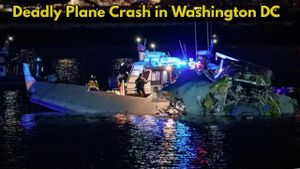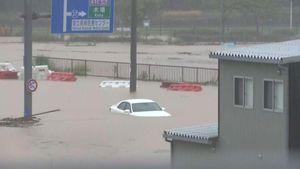Investigators are intensifying their search to determine the cause of the collision between American Airlines Flight 5342 and an Army Black Hawk helicopter, with recovery crews still working to pull wreckage from the Potomac River. Initial concerns have already surfaced about the path of at least one of the aircraft involved.
The Black Hawk was on a training mission when it collided Wednesday night with the commercial plane approaching Washington’s Reagan National Airport. Tragically, all 64 individuals aboard the plane and three soldiers in the helicopter were reported deceased.
The National Transportation Safety Board (NTSB), which is spearheading the investigation, has indicated it will take about 30 days to release a preliminary report, with the final report taking considerably longer. "We are currently evaluating all data and gathering information to determine the probable cause of the incident," the NTSB stated.
Emerging details suggest the helicopter may have been flying too high. According to the Federal Aviation Administration (FAA) charts, helicopters operating within the designated corridor around Washington should maintain altitudes at or below 200 feet above sea level. Flight tracking data indicates the Black Hawk was flying 100 feet above its allowed altitude and veering off its designated route along the Potomac River's east side.
"Based on the data we’re able to see, I think it’s fair to assess the situation as concerning," remarked Ian Petchenik, spokesperson for the flight tracking company FlightRadar24. Notably, the Black Hawk was sending Mode S signals, which provide limited information, as compared to the ADS-B signal from the American Airlines flight, which contains extensive flight details.
Both President Donald Trump and Defense Secretary Pete Hegseth raised concerns about the altitude of the helicopter during press events. Trump stated, "The Blackhawk helicopter was flying too high, by a lot. It was far above the 200-foot limit," whereas Hegseth added, "Was the Black Hawk too high? Was it on course? Right now, we don’t quite know."
These initial comments reflect the confusion surrounding the specifics of the incident.
At the time of the collision, merely 300 feet separated the prescribed flight paths of the jet and the helicopter. CNN aviation analyst Miles O’Brien noted, "That’s a very tight, no-margin-for-error airspace arrangement, which demands complete precision from all pilots involved." Investigators now face the pivotal task of determining if slight altitude changes could have potentially prevented this devastating collision.
Following the crash, the FAA announced the indefinite closure of the low-altitude helicopter corridor where the crash transpired, indicating potential changes to helicopter routes over the Potomac River could be forthcoming. The NTSB is evaluating the human factors, machinery involved, and environmental conditions to conclude what transpired.
Authorities have recovered the flight data and cockpit voice recorders – commonly referred to as black boxes – from both the jet and the helicopter. "We have begun analyzing the recordings, which will provide key information about the cockpit operations during the moments leading up to the collision," NTSB member Todd Innman stated.
Lending to the severity of the situation, video footage taken just before the disaster shows no signs of evasive maneuvers from either aircraft. Eyewitnesses relayed horror as they observed the two vehicles collide, resulting in a massive fireball and debris dispersing across the Potomac.
Prior to the crash, air traffic controllers directed the helicopter to pass behind the passenger plane. Audio captured from the air traffic control communications revealed, "PAT 2-5, do you have the CRJ (the code for the American Airlines flight) in sight?" Shortly thereafter, the controller instructed the helicopter to maintain visual separation from the commercial jet. The failure to execute these instructions raises questions about situational awareness among the helicopter crew.
A former Black Hawk pilot, Elizabeth McCormick, shared her concerns about the helicopter possibly being understaffed, asserting, "Visibility from the front is limited, especially if there is only one crew chief. This raises major safety issues."
Compounding the incident, reports indicate one air traffic controller at Reagan National Airport handled both local and helicopter traffic on the night of the crash. While this practice is not uncommon, sources present suggested it was not standard for this time of day and level of traffic.
Despite the tragic details, the investigation continues to evolve, with officials emphasizing the necessity of thorough examination rather than rushing to conclusions. US Sen. Tammy Duckworth, who is also a former Black Hawk pilot, sought clarity on the events, expressing hope for comprehensive disclosures from investigators, including transcripts of communications with the pilots.
This collision raises pressing questions about aviation safety protocols within congested airspace and heightens scrutiny of the protocols surrounding military helicopter operations within the Washington area. The crash, now the deadliest aviation incident on US soil since 2001, evoked national mourning as families mourn loved ones lost.
Rescue teams continue the recovery efforts amid challenging weather conditions, and authorities are making arrangements for memorials to honor the service members and civilians involved. The situation has cast suspicion over the existing air traffic measures and protocols employed by the FAA and military aviation branches.
Current datelines reveal significant public interest and scrutiny surrounding air traffic control effectiveness and safety measures, especially involving dense air spaces like those surrounding Washington, D.C. The community looks forward to insights expected from the NTSB’s thorough investigation, which would elucidate the tragic events of the dreadful evening when Flight 5342 met its fate.



